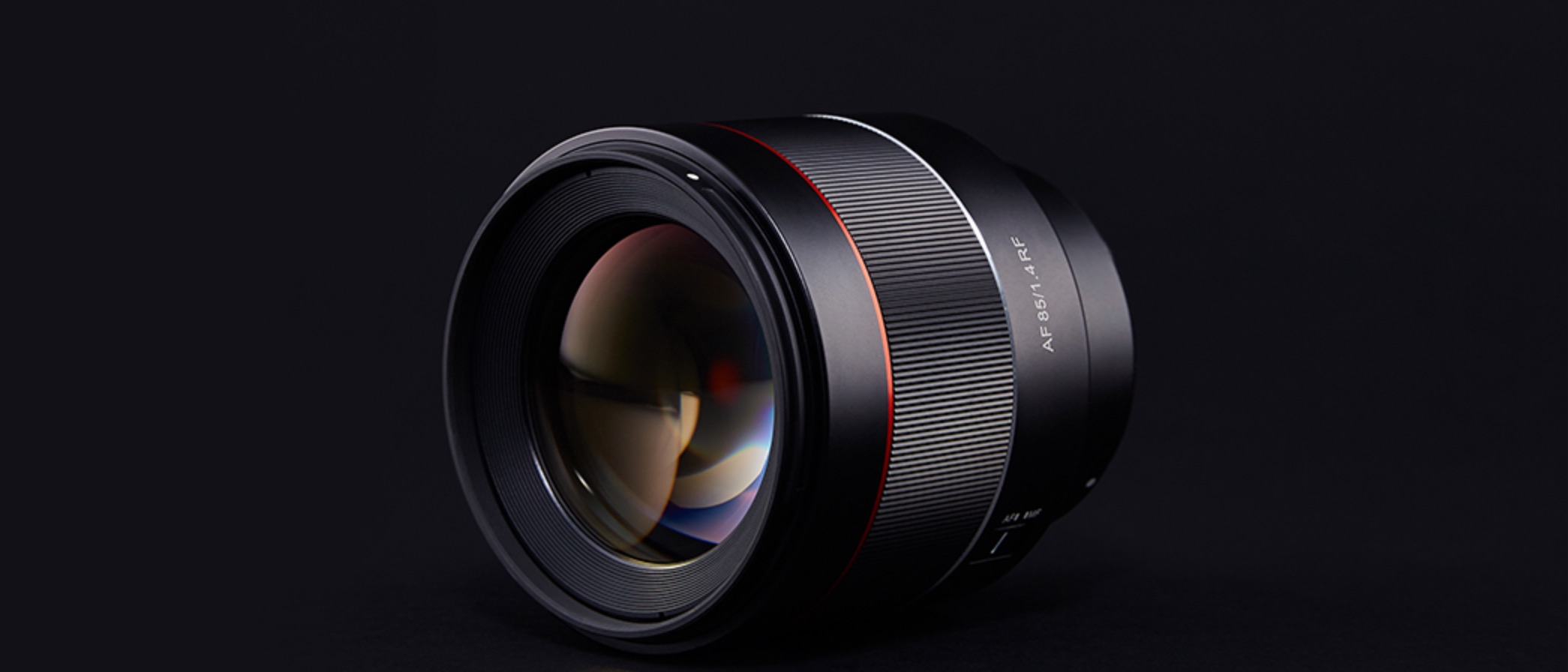Digital Camera World Verdict
Following its award-winning 14mm autofocus ultra-wide for the RF mount, Samyang reprises another of its favourite prime focal lengths for its next AF RF offering, creating yet another hard-to-resist value proposition. It's well made and can hold its own against more expensive alternatives, making it a very compelling option for Canon RF system users looking for a fast prime.
Pros
- +
Affordable
- +
Well made optically
- +
Weather sealed
Cons
- -
No in-camera lens corrections
- -
Exposure metering and autofocus can malfunction
Why you can trust Digital Camera World
If you’re a lens maker then, after the obligatory ‘fast fifty’, the next badge of honour is an f/1.4-speed 85mm short telephoto prime – the classic portrait lens. You just have to do one, but the optical design leaves nowhere to hide. It looks deceptively simple, but there are many challenges related to the large diameter and the need to effectively deal with a range of aberrations – spherical, comatic and chromatic, both longitudinal and lateral – while also delivering high contrast, low flare and a uniformity of both brightness and sharpness across the frame, even when shooting wide-open at f/1.4.
Samyang has built quite a few 85mm f/1.4 primes over the years – in fact, there are at least four different versions in the current line-up – and these have ranged in optical performance from great to brilliant. Samyang has built its reputation on manual focus primes (it still doesn’t make any zooms) that deliver a performance far exceeding what might be expected for the asking price. The cinematography world was pretty much the first to recognise the superb value of Samyang primes – the company now builds lenses specifically for this application with its Xeen range – and photographers soon got the message too.
More recently, Samyang has been making autofocus lenses, first for DSLRs and now for mirrorless cameras. Having been the first ‘independent’ to offer lenses in the Canon RF and Nikon Z full-frame mirrorless mounts (yes, one of them being an 85mm f/1.4), Samyang launched its first autofocus lens for the former, the AF 14mm f/2.8 RF, which immediately bagged the Best Mirrorless Wide-Angle Prime Lens prize in the 2020 TIPA World Awards (against, we might add, some pretty credentialed competition).
Logically then, next comes an 85mm f/1.4 and it’s another new interpretation of this combination of focal length and maximum aperture, leveraging the potential benefits of the RF mount’s shorter flange back distance. Canon itself offers two versions of its f/1.2 speed 85mm in the RF mount, so they’re slightly faster but they’re also a whole lot more expensive… actually in the order of over three times more expensive. Ouch!
Specifications
Name: Samyang AF 85mm f/1.4 RF
(also sold as Rokinon AF 85mm f/1.4 RF)
Mount: Canon RF
Autofocus: Yes
Full frame: Yes
Image stabilization: No
Lens construction: 11 elements in 8 groups
Angle of view: 28.9 degrees
Minimum focus: 90cm
Maximum reproduction ratio: 1:9.1
Aperture range: f/1.4 to f/16
Filter size: 77mm
Weight: 583.8g
Build and handling
Physically, the AF Samyang 85mm f/1.4 is a fairly substantial lens, but not excessively so. In numbers, it’s 97.5mm in length and 88mm in diameter – giving a 77mm
screwthread filter fitting – while tipping the scales at just under 584g.
The barrel tubes are aluminium alloy and the external construction is weather-sealed, including a pretty substantial gasket around the lens mount – a machined stainless steel component. As with all Samyang’s metal-bodied primes, it feels solidly made and the matte black finish is very smart.
The best camera deals, reviews, product advice, and unmissable photography news, direct to your inbox!
Unlike, Samyang’s manual focus RF lenses, the mount is fully interactive, incorporating the full array of 12 communication pins that allow, among other things, autofocus and aperture setting controls from the camera body, and the relay of capture data from the lens.
Consequently, there’s no manual aperture collar and the one, comparatively deep, control ring is obviously for manual focusing. It’s an electronic ‘fly-by-wire’ control, but feels a lot more substantially weighted than any other we’ve experienced before and so has the feel of a mechanical ring. The only other item on the barrel is a switch for flicking between AF and MF operation.
While the mount has the full set of RF system communication pins, it doesn’t support in-camera lens corrections, which is a little curious because the AF 14mm f/2.8 RF does. We tested the lens on the original EOS R and it certainly recognises the lens – the legend “SAMYANG RF 85mm F1.4” is displayed – but go any further and the display reads “Cannot correct – no data”. It’s very likely that this will come via a firmware upgrade – Samyang offers a docking module for this – but perhaps the company is happy enough with the lens’s optical correction. We shall see.
What’s also missing, obviously, is the multi-function control ring that’s a feature on all of Canon’s RF lenses.
Features
Inside, the optical construction comprises 11 elements in eight groups, which includes five special types – one made from optical glass with extra-low dispersion (ED) characteristics and four with high-refractive characteristics. Collectively, these correct for lateral chromatic aberrations and also optimise the uniformity of centre-to-corner sharpness.
Samyang’s Ultra Multi Coating (UMC) is applied to all the air surfaces, followed by a process called ‘Ion Beam Sputtering’ to provide more effective suppression of internal reflections, subsequently minimising ghosting and flare.
The electromagnetically-controlled diaphragm has nine blades to give more rounded out-of-focus effects, which is important given the very shallow depth-of-field that exists at f/1.4 and 85mm. The focusing group is internal and is driven by a pair of ultrasonic drives – which Samyang calls Dual Linear Sonic Motors – to ensure fast and accurate operation. The minimum focusing distance is 90cm, so this isn’t a lens for close-up work.
On the EOS R, the Samyang 85mm f/1.4 autofocused rapidly and reliably in both the single-shot and continuous AF modes. While not totally silent – there’s a very low whirr – it’s certainly very quiet.
All the Canon AF functionality is retained, including the focus area options, face/eye detection and subject tracking. The latter two work as well as we’ve seen with any branded Canon RF lens. With manual focusing, you still get the option of a focus peaking display and Canon’s ‘Focus Guide’ display, which indicates the degree of back or front focus (via a trio of tiny pointers in the live view display), as well as confirming when the subject is in focus.
Performance
Samyang has already set the bar high with its manual-focus MF 85mm f/1.4 RF for the Canon full-frame mirrorless mount, so the AF lens is already facing a bit of an in-house challenge. It doesn’t disappoint, especially in the context of the affordability factor.
Sharpness and contrast are very good at f/1.4, but inevitably get even better by f/2.8, so these images really pack a punch. Fine detailing is beautifully resolved, so we’re very confident that the lens will be able to compliment the EOS R5’s higher-res, 45MP sensor.
There’s great differentiation too, so you can really make the most of the selective focusing possibilities, with a sharply-focused subject really standing from a creamily smooth out-of-focus background... such is the smoothness of the transitions. Not surprisingly then, it’s a great portrait lens, but also works exceedingly well with graphic and highly-detailed subjects.
There’s some noticeable vignetting at f/1.4 – which, of course, some photographers actually like for portraiture, but may be too much for others. Again, the uniformity of frame brightness steadily improves as you stop down and any fall-off is gone by f/4.0.
Distortion is so negligible it’s just not going to be an issue with real-world shooting, even with subjects exhibiting lots of straight edges or lines. Chromatic aberration is also very well managed, with only the tiniest amount of fringing evident along some high-contrast edges when the image is significantly enlarged. As with distortion, this isn’t going to be problematic with normal shooting (compared to test charts).
Given the huge expanse of the front element, some flaring will occur when sunlight falls across its surface, which is presumably why Samyang supplies a pretty deep lens hood. As an aside, it’s going to be well worth investing in a protective filter for the front of the 85mm too, especially for the times when you’re shooting without the shade and all that precious glass is more at risk.
Verdict
Both the physical and optical construction of the AF 85mm f/1.4 RF make you wonder how Samyang can do it for the money. The value factor undoubtedly tops the list of reasons why you’d buy this lens, but obviously only because it doesn’t involve any significant compromises.
It’s very well made and, optically, easily holds its own against quite a number of the more expensive 85mm f/1.4 primes currently on the market. In terms of the RF mount, Canon’s own 85mm f/1.2 L series lenses – especially with the effective but expensive Blue Spectrum Refractive optics – are inevitably superior in some performance areas, but you’ll be paying dearly for it.
The Samyang AF 85mm f/1.4 RF doesn’t just offer a hard-to-resist balance of performance and price, but also a very good reason for Canon RF system users to own one of the iconic fast primes with all its great creative potential.
Read more
Best Canon RF lenses
Best Samyang lenses
Canon RF 85mm f/1.2L USM review
Canon RF 85mm f/1.2L USM DS review

Paul has been writing about cameras, photography and photographers for 40 years. He joined Australian Camera as an editorial assistant in 1982, subsequently becoming the magazine’s technical editor, and has been editor since 1998. He is also the editor of sister publication ProPhoto, a position he has held since 1989. In 2011, Paul was made an Honorary Fellow of the Institute Of Australian Photography (AIPP) in recognition of his long-term contribution to the Australian photo industry. Outside of his magazine work, he is the editor of the Contemporary Photographers: Australia series of monographs which document the lives of Australia’s most important photographers.








